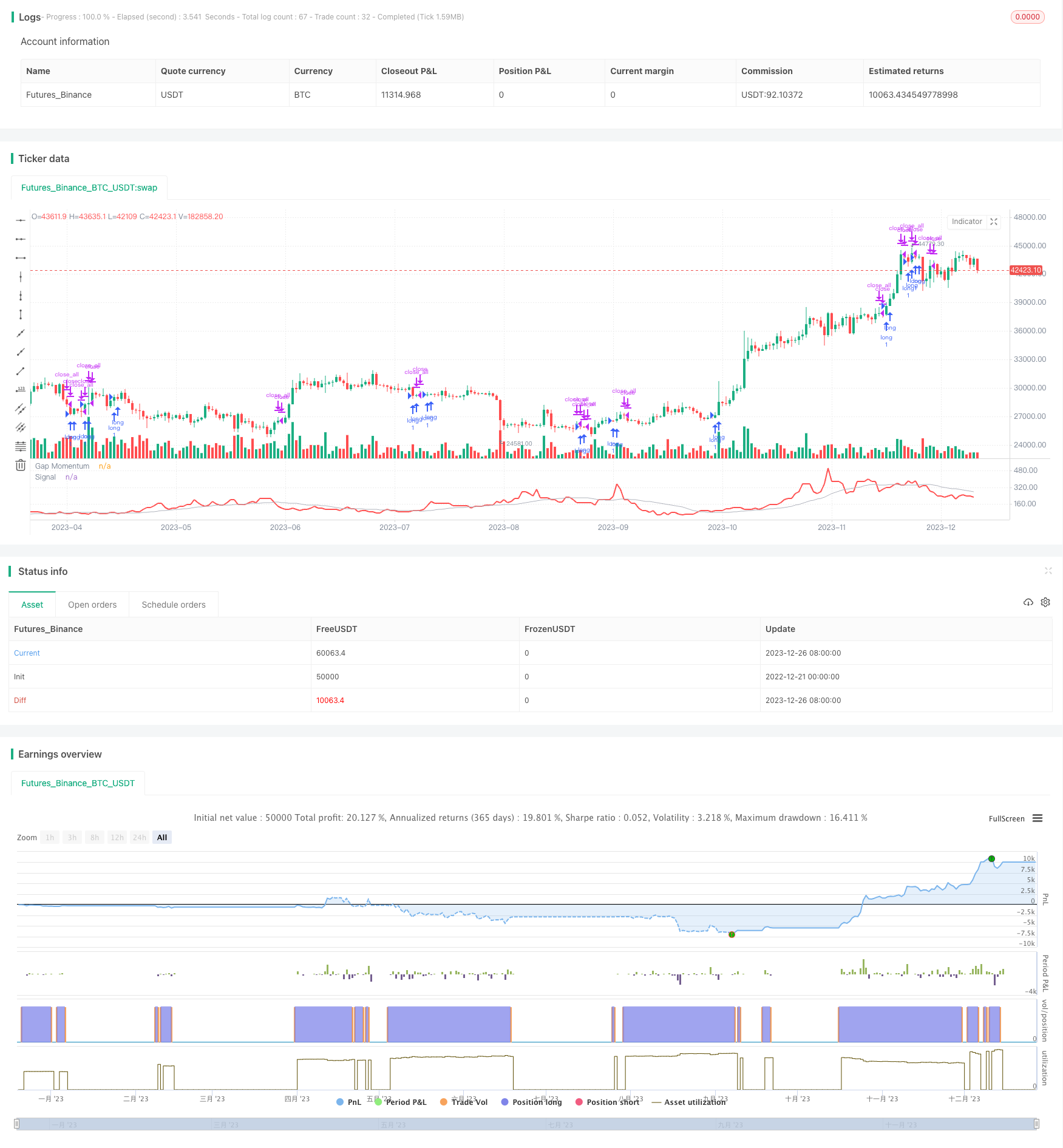
概述
动量孔隙交易策略(Momentum Gap Trading Strategy)是一种追踪价格波动的量化交易策略。它利用开盘价与前一天收盘价之间的差距(称为孔隙)来构建一个动量指标,并以该指标生成交易信号。该策略适用于高波动性股票,可捕捉价格跳空后的继续运行。
本策略基于波音公司前量化分析师佩里·考夫曼(Perry J. Kaufman)在2024年1月《技术分析杂志》上发表的文章《孔隙动量指标》。考夫曼构建了一个跟踪孔隙的动量时间序列,并提出使用该时间序列的移动平均线作为交易信号。当动量指标上穿其移动平均线时做多,下穿其移动平均线时平仓。
策略原理
动量孔隙策略的关键在于构建孔隙动量时间序列。构建思路类似于量化术语“弹性量”(On-Balance Volume,OBV),只不过使用的价格输入由每日收盘价变为每日孔隙。
具体计算流程是:
- 计算最近N天正孔隙总和与负孔隙绝对值之比
- 将比率累加构成孔隙动量序列
- 对孔隙动量序列应用移动平均生成信号
正孔隙定义为开盘价高于前一日收盘价的差值,负孔隙则相反。比率在本质上反映了最近一段时间内正孔隙与负孔隙的强度对比。
移动平均线抚平了原始波动序列,可用来发出交易信号。本策略采用了一个慢速移动平均线,当快速孔隙动量指标上穿慢速移动平均线时做多,下穿时平仓。
优势分析
与传统技术指标相比,动量孔隙策略具有以下优势:
- 利用价格跳空捕捉市场失衡
价格跳空(Gap)代表了巨大的供需失衡,跳空方向代表了市场议价权转移。本策略通过空隙比较市场多空力量,可有效捕捉这种失衡。
- 具有持续性
价格跳空后往往伴随趋势的继续,追踪跳空动量可捕捉价格趋势波段。指标设计增强了这种持续性特征。
- 参数少,实施简单
整个指标只包含两个参数,一个追踪动量的窗口期和一个信号平滑期。非常易于实施。
- 可量化,适合自动交易
采用数值比较清晰的交易规则,标准化程度高,可直接连接自动交易系统,适合程序化交易。
风险分析
尽管有许多优点,动量孔隙策略也存在一些风险:
- 容易产生错误信号
价格跳空短期内可能出现回补,进而使指标产生错误信号。may generate false signals as gaps may fill shortly after opening.
- 无法有效处理震荡行情
当价格出现频繁震荡时,指标将会发出大量互相抵消的交易信号。
- 潜在的过优化问题
仅仅两个参数很容易导致在历史数据上过度优化。must be careful not to overfit.
建议通过以下方式来控制风险:
采用止损来限制单笔损失
增加参数以适应更多市场状态
多组合优化以防范过优化
优化方向
本策略可从以下几个维度进行扩展与优化:
- 多个时间周期组合
采用不同追踪动量窗口的多个孔隙指标,不同周期间可起到互补效果。
- 整合跳空指标
例如将真实间隙指标与ATR指标整合作为风险管理。manage risk with ATR.
- 考虑跳空各方面
例如跳空距离、跳空次数、跳空产生日等更多特征。incorporate more gap characteristics.
- 机器学习模型
使用跳空数据训练更复杂的机器学习模型,may achieve better performance.
总结
动量孔隙策略是一个简单但实用的突破类策略。它跟踪价格跳空这一市场微观结构变化,挖掘隐藏在其中的剧烈供需变化。与其他技术指标相比,它能更清楚地反映市场失衡,并迅速抓住价格趋势转折点。尽管如此,仍需要辅以风险控制手段以避免潜在问题。本策略为我们提供了一个基于市场结构识别机会的范例,值得我们在实践中做进一步优化与创新。
/*backtest
start: 2022-12-21 00:00:00
end: 2023-12-27 00:00:00
period: 1d
basePeriod: 1h
exchanges: [{"eid":"Futures_Binance","currency":"BTC_USDT"}]
*/
// TASC Issue: January 2024 - Vol. 42, Issue 1
// Article: Gap Momentum Indicator
// Taking A Page From The On-Balance Volume
// Article By: Perry J. Kaufman
// Language: TradingView's Pine Script™ v5
// Provided By: PineCoders, for tradingview.com
//@version=5
string title = 'TASC 2024.01 Gap Momentum System'
string stitle = 'GMS'
strategy(title, stitle, false)
int period = input.int( 40, 'Period:')
int signalPeriod = input.int( 20, 'Signal Period:')
bool longOnly = input.bool(true, 'Long Only:')
float gap = open - close[1]
float gapUp = 0.0
float gapDn = 0.0
switch
gap > 0 => gapUp += gap
gap < 0 => gapDn -= gap
float gapsUp = math.sum(gapUp, period)
float gapsDn = math.sum(gapDn, period)
float gapRatio = gapsDn == 0?1.0:100.0*gapsUp/gapsDn
float signal = ta.sma(gapRatio, signalPeriod)
if strategy.opentrades <= 0 and signal > signal[1]
// buy at next open:
strategy.entry('long', strategy.long)
else if strategy.opentrades > 0 and signal < signal[1]
if longOnly
// close all at next open:
strategy.close_all()
else
// sell at next open:
strategy.entry('short', strategy.short)
plot(gapRatio, 'Gap Momentum', color.red, 2)
plot(signal, 'Signal', color.silver, 1)